ORDER
Ciconiiformes
FAMILY
Ardeidae
GENUS & SPECIES
KEY FEATURES
• Wades in shallow ater on elegant, stiltlike legs to fish for prey
• Hunts by standing statue-still and waiting for prey to drift into range, or by pacing slowly until it detects the slightest underwater movement
• Shoots its long neck out like a snake, stabbing prey with its bill
• Nests in noisy treetop colonies called heronries
WHERE IN THE WORLD?
Breeds further north than any other heron, from Britain and southern Scandinavia across Russia to Japan, ranging south to India, the North African coast and other parts of Africa

LIFECYCLE
Hunting almost any small animal within striking distance, the gray heron moves with a blend of stately grace and deadly power, launching its killing blows without warning.
Habitat
The gray heron is found wherever there’s shallow water to hunt in, whether salty or fresh, stagnant or fast-flowing. Most of the year, its preferred habitats are low-lying rivers, ponds, lakes, reservoirs and marshes, but it also occurs in areas with waterlogged ground, such as floodplains, damp grassland and rice paddies. In the north, it moves to coastal mudflats, salt marshes, deltas and estuaries in winter, where the climate is mild and waters rarely freeze; in other areas it spends all year by the coast.The adaptable heron breeds from sea level up to altitudes of 6,600′.
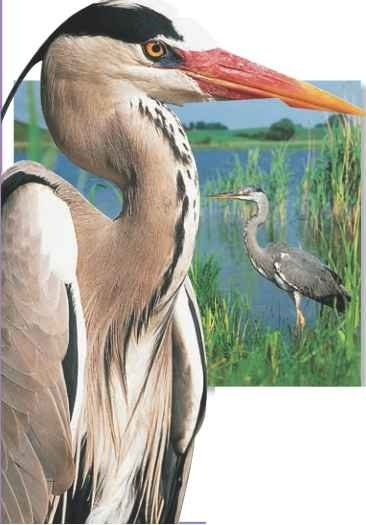
A Stalker in the reeds Reedy margins of lakes and ponds are favorite hunting grounds, but the heron often wades in the smallest ditches and creeks.
Breeding
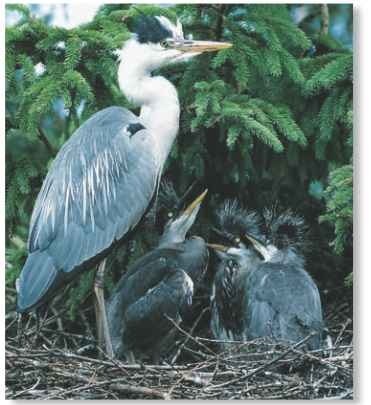
A Full house
Young fledge after about 6—7 weeks in the nest.
The heron breeds in treetop colonies, known as heronries, which have 10-200 nests, but are sometimes much larger
Pairs mate for life and return to the same nest each year, adding to the twig structure; eventually, the nest may collapse under its own weight. In areas where trees are scarce, the heron nests on cliffs, in reedbeds and bushes or on the ground.
In marked contrast to its silent nature, the gray heron is noisy and demonstrative at its colony, engaging in a neck-stretching courtship display and croaking deeply every time it arrives back at its nest. Both sexes incubate the eggs for about 3-4 weeks and then share the demanding task of keeping the chicks fed, regurgitating part-digested food straight into their bills.
# Herons occasionally visit garden ponds and will eat any fish they find.
# If heron eggs or chicks are destroyed, a pair will replace them up to three times.
Food & hunting
Any small creature that lives in the heron’s habitat may fall prey to this predator. As well as hunting fish, frogs and newts, it snatches insects, crustaceans, snakes and small mammals, such as water voles. Small waterbirds, and young ducks and wading birds in particular, risk their lives if they stray too close.
The heron uses two fishing strategies. It often lurks in ambush in the shallows, waiting for prey to approach. It also wades slowly and deliberately through the water with its neck pulled back in an S-shape while keeping watch for any movement that may betray a meal. When it spots prey, it darts its head forward at lightning speed, stabbing down with its bill to snap up or skewer its helpless victim. Small prey is swallowed headfirst, but larger victims are ferried to dry land to be dismembered and eaten piecemeal. Struggling eels often coil around the heron’s neck, forcing it to wrestle them off before stabbing them.
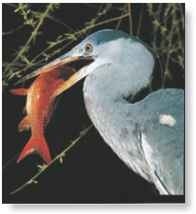
lightning strike

Stalk…
Ever poised to strike, a gray heron stalks slowly through the shallows at the margins of a lake, where small fish congregate.
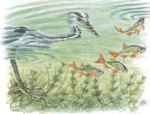
Spot…
The heron slowly strides to a glittering shoal of fish, which remain unaware of the danger lurking above the surface.
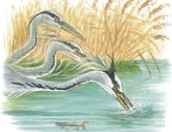
Strike…
In one swift action, the heron straightens its neck and lunges forward, stabbing the water with its bill to snatch a victim.
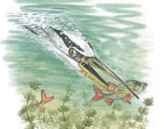
Stab
The heron’s prey squirms as it’s hoisted out of the water, but in vain — the razor-sharp edges of its bill provide a secure grip.
Behavior
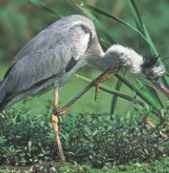
A Well groomed The heron cleans itself with “powder down” (like human talcum powder).
Cautious and wary, the heron lies low in the day, becoming active at dusk and dawn. It’s solitary, as its hunting technique depends upon silent stealth, but it doesn’t defend a territory.
In flight, the heron tucks its neck back to its body — unlike long-necked birds such as storks, which fly with the neck outstretched. Seen from a distance on its long broad wings, it resembles a bird of prey.
The grooming habits of the gray heron are unusual. To remove fish slime and sticky scales from its plumage, it applies a fine powder formed from the crumbling tufts of special downy feathers. This powder absorbs any slime and grease, letting it be combed away easily.
Warming rays
A heron stretching out its wings to catch the sun.
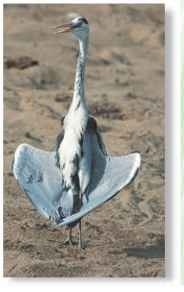
Conservation
In some ways, it’s surprising that the gray heron is an abundant species in much of its range. Large areas of its wetland habitats, especially lowland marshes, have been drained to create farmland, and its fishing skills make it so unpopular with fish farmers that many are shot each year — even in countries where it’s protected (including Britain). But the heron hunts such a range of prey and lives in so many habitats that it’s able to flourish regardless.
PROFILE
Gray Heron
Standing perfectly still, the gray heron is a patient predator. Suddenly, it strikes, unleashing the whiplash power of its neck to spear prey on its bill.
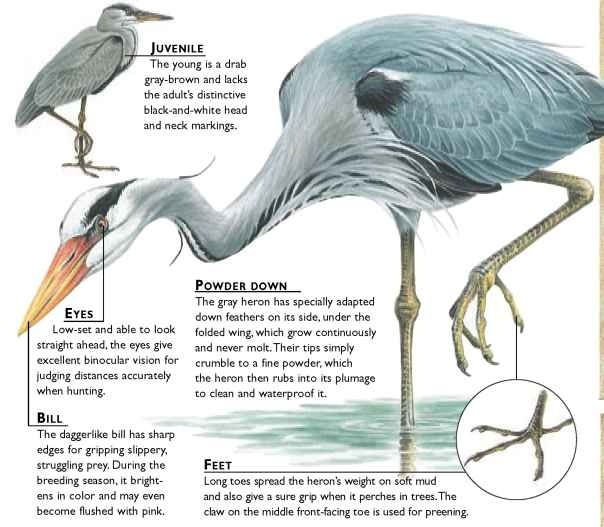
Creature comparisons
The long-legged, long-necked gray heron is a tall bird, but it’s dwarfed by the goliath heron, Ardea goliath.This hunter of African and Middle Eastern swamps stands up to 5′ high, but stalks its prey with stealthy efficiency, so is often overlooked in the ‘ dense reedbeds and mangroves. Like the gray heron, the goliath is intolerant of intruders; it will launch into the air with a deep, grating croak and flaps away over the marshes with leisurely wingbeats.
The goliath heron can wade into much deeper water than the gray heron, and fish make up a larger proportion of its diet. Its legs and bill are black, whereas those of its smaller relative are yellowish.
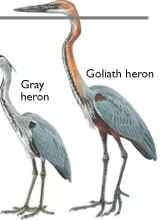
| VITAL | ||
| STATISTICS | ||
| Weight | 2.5-3.5 lbs. | |
| Length | 3-3.5′ | |
| Wingspan | 6-6.5′ | |
| Sexual Maturity | 2 years | |
| Breeding Season | Jan.-May in north; almost allyear in tropics 3-5 |
|
| Number of Eggs | ||
| Incubation Period | 21-26 days | |
| Fledging Period | 40-50 days | |
| Breeding Interval | 1 year | |
| Typical Diet | Fish, snakes, invertebrates, birds, mammals, amphibians | |
| Lifespan | 25 years | |
RELATED SPECIES
• The 60-strong family of herons, Ardeidae, has two tribes: the day-active herons, 34 species that includes the gray heron, egrets and the purple heron, Ardea purpurea (below); and the mainly nocturnal herons — the bitterns, night herons and tiger herons.


